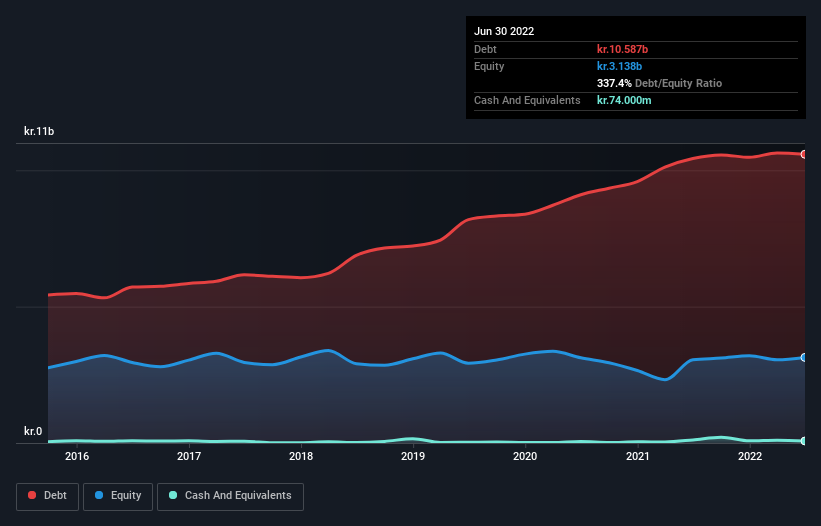- Denmark
- /
- Infrastructure
- /
- CPSE:KBHL
These 4 Measures Indicate That Københavns Lufthavne (CPH:KBHL) Is Using Debt Extensively

Warren Buffett famously said, 'Volatility is far from synonymous with risk.' It's only natural to consider a company's balance sheet when you examine how risky it is, since debt is often involved when a business collapses. We can see that Københavns Lufthavne A/S (CPH:KBHL) does use debt in its business. But should shareholders be worried about its use of debt?
Why Does Debt Bring Risk?
Debt and other liabilities become risky for a business when it cannot easily fulfill those obligations, either with free cash flow or by raising capital at an attractive price. Part and parcel of capitalism is the process of 'creative destruction' where failed businesses are mercilessly liquidated by their bankers. However, a more usual (but still expensive) situation is where a company must dilute shareholders at a cheap share price simply to get debt under control. Of course, debt can be an important tool in businesses, particularly capital heavy businesses. When we examine debt levels, we first consider both cash and debt levels, together.
See our latest analysis for Københavns Lufthavne
What Is Københavns Lufthavne's Debt?
As you can see below, Københavns Lufthavne had kr.10.6b of debt, at June 2022, which is about the same as the year before. You can click the chart for greater detail. And it doesn't have much cash, so its net debt is about the same.

A Look At Københavns Lufthavne's Liabilities
Zooming in on the latest balance sheet data, we can see that Københavns Lufthavne had liabilities of kr.1.13b due within 12 months and liabilities of kr.11.2b due beyond that. Offsetting these obligations, it had cash of kr.74.0m as well as receivables valued at kr.560.0m due within 12 months. So it has liabilities totalling kr.11.7b more than its cash and near-term receivables, combined.
This deficit isn't so bad because Københavns Lufthavne is worth kr.49.9b, and thus could probably raise enough capital to shore up its balance sheet, if the need arose. But we definitely want to keep our eyes open to indications that its debt is bringing too much risk.
In order to size up a company's debt relative to its earnings, we calculate its net debt divided by its earnings before interest, tax, depreciation, and amortization (EBITDA) and its earnings before interest and tax (EBIT) divided by its interest expense (its interest cover). This way, we consider both the absolute quantum of the debt, as well as the interest rates paid on it.
Weak interest cover of 0.40 times and a disturbingly high net debt to EBITDA ratio of 10.9 hit our confidence in Københavns Lufthavne like a one-two punch to the gut. This means we'd consider it to have a heavy debt load. One redeeming factor for Københavns Lufthavne is that it turned last year's EBIT loss into a gain of kr.60m, over the last twelve months. There's no doubt that we learn most about debt from the balance sheet. But it is Københavns Lufthavne's earnings that will influence how the balance sheet holds up in the future. So if you're keen to discover more about its earnings, it might be worth checking out this graph of its long term earnings trend.
Finally, a business needs free cash flow to pay off debt; accounting profits just don't cut it. So it is important to check how much of its earnings before interest and tax (EBIT) converts to actual free cash flow. Looking at the most recent year, Københavns Lufthavne recorded free cash flow of 24% of its EBIT, which is weaker than we'd expect. That's not great, when it comes to paying down debt.
Our View
While Københavns Lufthavne's net debt to EBITDA makes us cautious about it, its track record of covering its interest expense with its EBIT is no better. But its not so bad at staying on top of its total liabilities. We should also note that Infrastructure industry companies like Københavns Lufthavne commonly do use debt without problems. When we consider all the factors discussed, it seems to us that Københavns Lufthavne is taking some risks with its use of debt. While that debt can boost returns, we think the company has enough leverage now. The balance sheet is clearly the area to focus on when you are analysing debt. However, not all investment risk resides within the balance sheet - far from it. For example Københavns Lufthavne has 3 warning signs (and 2 which shouldn't be ignored) we think you should know about.
At the end of the day, it's often better to focus on companies that are free from net debt. You can access our special list of such companies (all with a track record of profit growth). It's free.
Valuation is complex, but we're here to simplify it.
Discover if Københavns Lufthavne might be undervalued or overvalued with our detailed analysis, featuring fair value estimates, potential risks, dividends, insider trades, and its financial condition.
Access Free AnalysisHave feedback on this article? Concerned about the content? Get in touch with us directly. Alternatively, email editorial-team (at) simplywallst.com.
This article by Simply Wall St is general in nature. We provide commentary based on historical data and analyst forecasts only using an unbiased methodology and our articles are not intended to be financial advice. It does not constitute a recommendation to buy or sell any stock, and does not take account of your objectives, or your financial situation. We aim to bring you long-term focused analysis driven by fundamental data. Note that our analysis may not factor in the latest price-sensitive company announcements or qualitative material. Simply Wall St has no position in any stocks mentioned.
About CPSE:KBHL
Københavns Lufthavne
Owns, develops, and operates Copenhagen Airport and Roskilde Airport in Denmark.
Solid track record with imperfect balance sheet.

